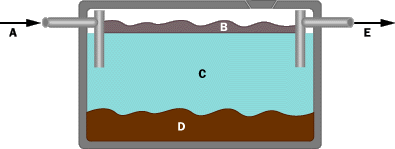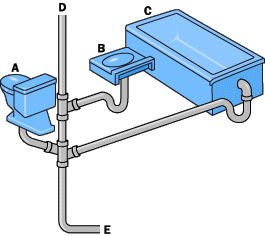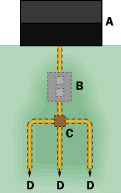In much of upstate New York, many houses are spaced so far apart that a sewer system would be too expensive to install. In these instances homeowners rely on a septic system for their wastewater management needs. These systems consist of a septic tank for waste treatment and some type of drain field for water disposal. The rest of this article will cover how they work and septic system basics.
A septic tank is simply a big concrete or plastic tank that is buried in the yard. The tank generally holds between 1,000 and 1,500 gallons of water. Wastewater flows into the tank at one end and leaves the tank at the other. The tank looks something like this in cross-section:

In this picture, you can see three layers. Anything that floats rises to the top and forms a layer known as the scum layer. Anything heavier than water sinks to form the sludge layer. In the middle is a fairly clear water layer. This body of water contains bacteria and chemicals like nitrogen and phosphorous that act as fertilizers, but it is largely free of solids.
Wastewater comes into the septic tank from the sewer pipes in the house, as shown here:


As new water enters the tank, it displaces the water that’s already there. This water flows out of the septic tank and into a drain field. The drain field is protected from getting clogged with solids by a bulkhead or pipe in the septic tank called the outlet baffle. The outlet baffle is arguably the most important part of a septic system as without it the system will clog and fail in short order.
A drain field is made of perforated pipes buried in trenches filled with gravel. The following diagram shows an overhead view of a house, septic tank, distribution box and drain field:

A typical drain field pipe is 4 inches in diameter with 1/2″ perforations every few inches and is buried in a trench that is 2.5 to 5 feet deep and 2 feet wide. The gravel fills the bottom 2 to 3 feet of the trench and dirt covers the gravel, like this:

The water is slowly absorbed and filtered by the ground in the drain field. The size of the drain field is determined by local building codes and the number of bedrooms in the home. In places with hard ground or clay, larger fields or the use of fill is required to get the drain field to function properly
A septic system is normally powered by gravity. Water flows down from the house to the tank, and down from the tank to the drain field. It is a completely passive system. In situations with poor drainage, it is sometimes necessary to construct mound or shallow absorption drain fields with electrical pumps driving the waste water up into the field.
Whichever kind of septic system you have in your home, routine pumping and cleaning is required to keep the system functioning normally. We recommend having your tank pumped and cleaned every two to three years to ensure proper function and long life. Please free to call our office at (518) 584-1048 if you have further questions on septic system basics.
